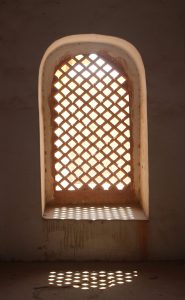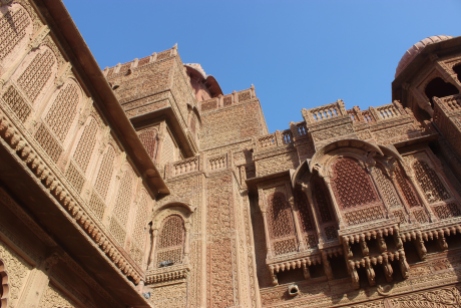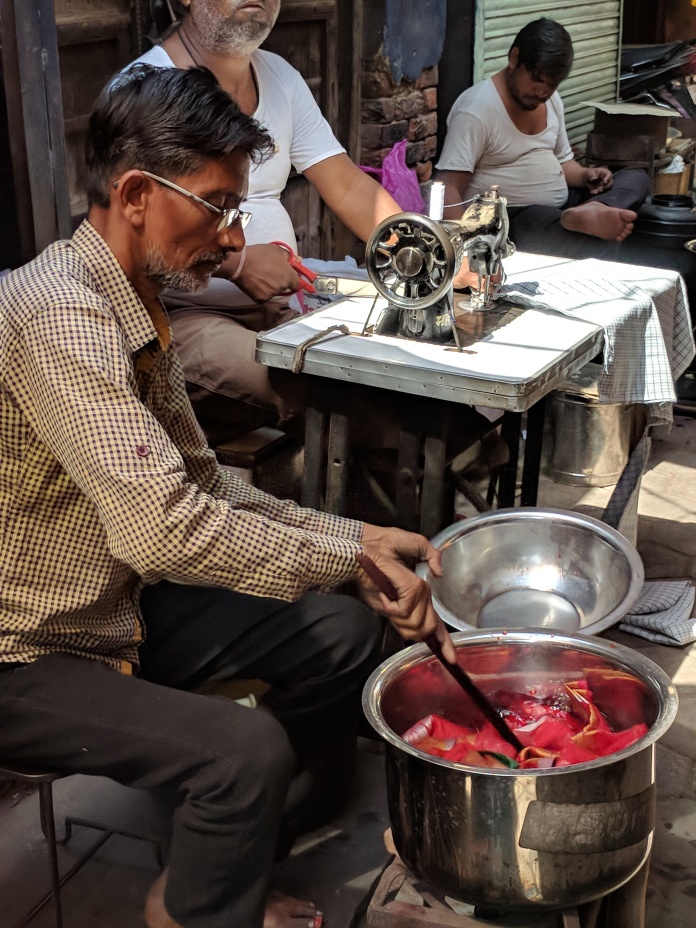 I first visited Bikaner in February 2013 as part of a larger tour of Rajasthan with a group. Bikaner, the fourth-largest city of Rajasthan, was our first stop and it turned out to be the perfect introduction to the state as well as the perfect beginning to what turned out to be a great trip.
I first visited Bikaner in February 2013 as part of a larger tour of Rajasthan with a group. Bikaner, the fourth-largest city of Rajasthan, was our first stop and it turned out to be the perfect introduction to the state as well as the perfect beginning to what turned out to be a great trip.
In the day-and-a-half that we had in Bikaner, our group was able to visit Junagarh Fort, the camel research station and the royal centotaphs at Devi Kund Sagar. We even managed to squeeze in a quick visit to the Bhandasar Jain Temple, but could not explore the city’s famed havelis and markets.
Five years later (and almost to the day in February 2018), I was back in Bikaner courtesy an invitation from Narendra Bhawan. And this time around, thanks to their curated trails, I was able to explore new places — the havelis and markets of Bikaner — and re-visit old ones like the royal cenotaphs. In addition, I also visited the Laxmi Niwas Palace and Bikaji ki Tekree, the site of the first fortified settlement in Bikaner. I also got the opportunity to travel out of the city into the desert one evening for a sundowner and a special dinner. An unexpected bonus of this trip was getting introduced to two master artists of Bikaner and an opportunity to see their work (more about this in a separate blogpost!).
Presenting my “Bikaner Revisited” experiences, beginning with a brief history of the city.
Bikaner was founded in 1488 by Rao Bika, one of the sons of Rao Jodha (the founder of Jodhpur). At that time, Bikaner was part of a larger region known as Jangladesh or the wilderness. It was actually an oasis in the Thar desert due to the presence of adequate fresh water and at the crossroads of many trade routes that branched out to Central Asia, Persia and China and, therefore, an important halt. Rao Bika built a fortified structure from a mixture of stone and mud at the highest point in the area. However, very little of the original structure survives today due to renovations. Today, this is known as Bikaji ki Tekree.
Rao Bika’s fortified structure is empty today and except for some chhatris or memorial stones covered with domes, there is little indication of what the various rooms were used for. There are no boards and it is anybody’s guess if a room was used as a temple or a guard room or a meeting hall or… Though Bikaji ki Tekree is clean, the sense of neglect is palpable and a tad unbelievable that Bikaner’s royal legacy began from this place.


Bikaji ki Tekree soon became an insufficient space for the royal family of Bikaner and a new fort was commissioned by the 6th King, Raja Rai Singh. Named Chintamani Durg, construction of the Fort was completed in 1593 and the royal family resided in the Fort till 1902 when they moved into Lalgarh Palace. Commissioned by Maharaja Ganga Singh and designed by Sir Samuel Jacob, the Lalgarh Palace is a grand vision in red sandstone.
Set amongst extensive and well maintained lawns, the intricately and delicately carved red sandstone exterior with jaalis, cupolas, and jharokhas gives way to a burst of colour and royal opulence once you enter inside. The Laxmi Niwas Palace is a part of the Lalgarh Palace, and is currently a heritage hotel. The grounds of the Lalgarh Palace also house the Sardul Heritage Museum (which is open to the public) and a Manuscripts Library (which is not).
A peek into Laxmi Niwas Palace in 6 photos is given below. Do click on the first picture and then use the right arrow key to see the others. Once you’ve seen this set, do come back to read the rest of the post, for there is more of Bikaner to experience.
While the cenotaph of a male royal has a vertical memorial slab, that of a female has feet engraved on a stone slab. A memorial for a minor is a simple structure called nada and does not have a chhatri covering it. The chhatris appear plain and unadorned until you look up and see the fabulous artwork inside the domes. As in my previous visit, the cenotaphs filled me with unease, so I concentrated on the artwork inside the domes. Some have been painted with gold, while others are frescoes with vegetable dyes. Most of the artwork, however, is in a bad condition.


Thanks to its strong connection to trade and being on the trade routes, Bikaner has always had a large number of prosperous traders and merchants. It is claimed that some of them were even richer than the Bikaner royals. It is, therefore, not surprising that the mansions or havelis built by the merchants are just as grand as a palaces. The good people at Narendra Bhawan arranged for a walking tour of the havelis — but only from the outside as most of them are private properties. We did manage to go inside one haveli-turned-heritage hotel. Since much has been renovated, I wonder how much of the original details have been lost.
The grand Rampuria Havelis took my breath away — the sheer scale, grandness, intricacy of its carved exteriors and the desolation of its tightly shut windows. It was a real pity that one cannot see the haveli interiors, which I suspect would be even more grander than the exteriors, and full of painted details. If you had seen our group on that February morning in 2018, you would have seen a bunch of women walking around with mouth agape and mindless of traffic. From delicate floral patterns to gods and goddesses, to kings and queens, to scenes from everyday life to women drinking from a bottle, the haveli exteriors had it all.
A selection of the many photos I took of the havelis. Do click on the first picture and then use the right arrow key to see the others. Once you’ve seen this set, do come back to read the rest of the post, for there is more of Bikaner to experience.
Some impressions from the markets are up next. Do click on the first picture and then use the right arrow key to see the others. Once you’ve seen this set, do come back to see the video of kesar milk shake being mixed, and to read the remaining part of the post.
The second visit to Bikaner saw my wish of seeing the havelis and markets getting fulfilled. And I returned to Mumbai with a wish to visit the city again. One can never see everything now, right? One has to leave something for the next visit, right?
 There is so much left to see in Bikaner and maybe revisit again. I chose not to visit the Junagarh Fort this time, as I had visited it on my first visit. However, on my next visit to Bikaner (whenever that will be), visiting the Fort will be a must. I wanted to visit the Manuscripts Library located in the grounds of the Lalgarh Palace, but unfortunately there were so many levels of permissions required and so little time that I had to give up the idea. But the next time I visit Bikaner, the Manuscripts Library will be a priority.
There is so much left to see in Bikaner and maybe revisit again. I chose not to visit the Junagarh Fort this time, as I had visited it on my first visit. However, on my next visit to Bikaner (whenever that will be), visiting the Fort will be a must. I wanted to visit the Manuscripts Library located in the grounds of the Lalgarh Palace, but unfortunately there were so many levels of permissions required and so little time that I had to give up the idea. But the next time I visit Bikaner, the Manuscripts Library will be a priority.
On my next visit, I want to focus on Bikaneri art forms like Usta or gold embossing work that is done on the walls, glass, wooden and marble surfaces, and also artifacts made of camel leather. I met an usta artist at Narendra Bhawan and saw his work (see photo on left) on camel leather, but unfortunately could not spend much time with him understanding his art and its processes.
I leave you with a video of the interior of a room in a haveli-turned-hotel whose wall has usta work on it and is a perfect mix of a traditional design on a contemporary wall colour.
So Bikaner, when are you calling me again? 🙂
Disclaimer: I was invited by Narendra Bhawan to visit and experience their hospitality and their curated trails to explore Bikaner. This post is an outcome of that exploration; needless to say, the views and words are all mine.
More from Bikaner: Forts of Rajasthan – 1: The Junagarh Fort of Bikaner | There’s something about camels ! | The Narendra Bhawan Experience
Join me on Twitter, Facebook and Instagram as I explore the world around me and share “My Favourite Things” with you.

























What a beautiful collection of images of Rajastan, Sudha, their Havelis are just gorgeous. I was lucky to stay in a real old one in Ahemadabad, on my first trip to Indian about 3 years ago. Thank you for sharing the beauty with us.
LikeLike
Thank you, Cornelia. I have stayed in a haveli too in Shekhawati and thoroughly enjoyed the experience. I would love to stay in a Bikaneri haveli, though.
LikeLiked by 1 person
Simply beautiful. The Usta work is amazing.
LikeLike
I saw Usta work during my first visit in 2013 too, but this time I was able to see even more of it and meet an artist as well. In my next trip I would like to spend some time with an Usta artist.
LikeLiked by 1 person
So beautiful
LikeLike
Bikaner is a beautiful city and one of my favourite places in India.
LikeLike
Lovely post on Bikaner!
LikeLike
Thank you very much, Niranjan.
LikeLike